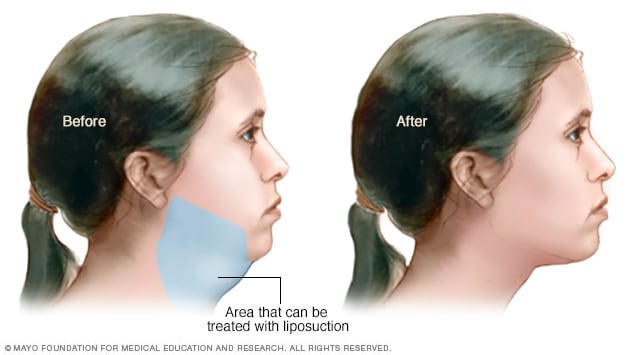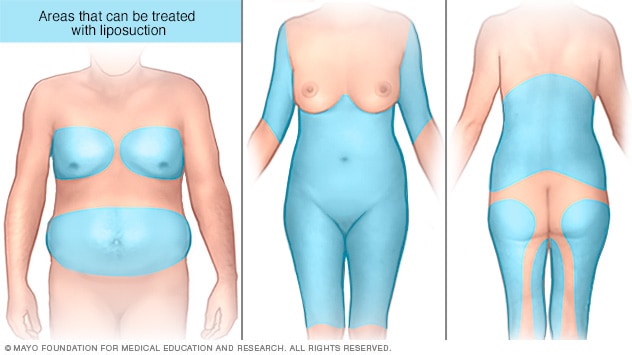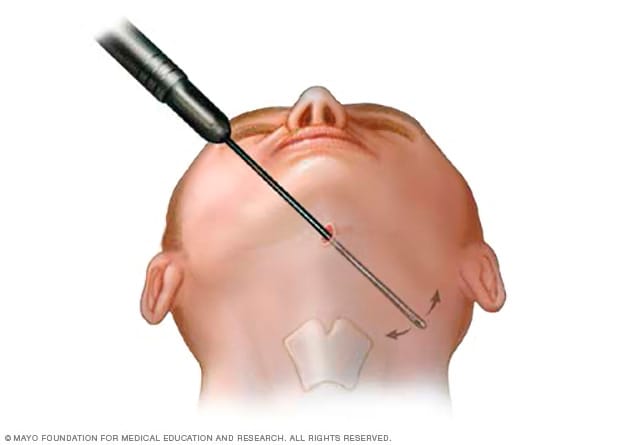Overview
Liposuction is a type of surgery. It uses suction to remove fat from specific areas of the body, such as the stomach, hips, thighs, buttocks, arms or neck. Liposuction also shapes these areas. That process is called contouring. Other names for liposuction include lipoplasty and body contouring.
Liposuction isn’t considered an overall weight-loss method or a weight-loss alternative. People who are overweight can lose more weight through diet and exercise or through other kinds of surgery than with liposuction.
Liposuction may work for you if you have a lot of body fat in specific places but otherwise have a stable body weight.
Products & Services
Why it's done
Liposuction under chin

Liposuction under chin
Blue shading shows the area under the chin that can be treated with liposuction.
Liposuction treatment areas

Liposuction treatment areas
Blue shading shows areas on the body — including the abdomen, chest, back, legs and arms — that can be treated with liposuction.
Liposuction removes fat from areas of the body that don't respond to diet and exercise. These include the:
- Abdomen.
- Upper arms.
- Buttocks.
- Calves and ankles.
- Chest and back.
- Hips and thighs.
- Chin and neck.
In addition, liposuction can sometimes be used to reduce extra breast tissue in men — a condition called gynecomastia.
When you gain weight, fat cells get bigger. Liposuction lowers the number of fat cells in a specific area. The amount of fat removed depends on what the area looks like and the volume of fat. The resulting shape changes are usually permanent as long as your weight remains the same.
After liposuction, the skin molds itself to the new shapes of the treated areas. If you have good skin tone and elasticity, the skin usually looks smooth. If your skin is thin and not elastic, the skin in the treated areas may look loose.
Liposuction doesn't help with dimpled skin from cellulite or other differences in the surface of the skin. Liposuction also doesn't remove stretch marks.
To have liposuction, you must be in good health without conditions that could make surgery more difficult. These can include blood flow problems, coronary artery disease, diabetes or a weak immune system.
Risks
As with any surgery, liposuction has risks. These risks include bleeding and a reaction to anesthesia. Other risks specific to liposuction include:
- Contour irregularities. Your skin may appear bumpy, wavy or withered due to uneven fat removal, poor skin elasticity and scarring. These changes may be permanent.
- Fluid buildup. Temporary pockets of fluid, called seromas, can form under the skin. They may need to be drained using a needle.
- Numbness. You may feel temporary or permanent numbness in the treated areas. Nerves in the area also may feel irritated.
- Infection. Skin infections are rare but possible. A severe skin infection may be life-threatening.
- Internal puncture. Rarely, if the thin tube used during surgery penetrates too deeply, it may puncture an internal organ. This may require emergency surgery to repair the organ.
- Fat embolism. Pieces of fat may break away and become trapped in a blood vessel. They then may gather in the lungs or travel to the brain. A fat embolism is a medical emergency.
- Kidney and heart problems. When large volumes of liposuction are performed, fluid shifts. This can cause possibly life-threatening kidney, heart and lung problems.
- Lidocaine toxicity. Lidocaine is a medicine that is used to help manage pain. It's often given with fluids injected during liposuction. Although lidocaine usually is safe, lidocaine toxicity sometimes can occur, causing serious heart and central nervous system problems.
The risk of complications rises if the surgeon works on larger body surfaces or does multiple procedures during the same operation. Talk to the surgeon about how these risks apply to you.
How you prepare
Before the procedure, discuss with your surgeon what to expect from the surgery. Your surgeon will review your medical history and ask about any medical conditions you may have. Tell the surgeon about any medicines, supplements or herbs you are taking.
Your surgeon will recommend that you stop taking certain medicines, such as blood thinners or nonsteroidal anti-inflammatory drugs (NSAIDs), at least a week before surgery. You also may need to get certain lab tests before your procedure.
If only a small amount of fat is to be removed, the surgery may be done in a clinic or medical office. If a large amount of fat will be removed or if you have other procedures done at the same time, the surgery may take place in a hospital. In either case, find someone to drive you home and stay with you for at least the first night after the procedure.
What you can expect
Before the procedure
Suction-assisted liposuction procedure

Suction-assisted liposuction procedure
During suction-assisted liposuction, the most common type of liposuction, the surgeon uses a thin tube attached to a vacuum to remove fat from under the skin. In some cases, the surgeon might insert the tube through several points to treat an area from different angles.
Before your liposuction procedure, the surgeon may mark circles and lines on the areas of your body to be treated. Photos also may be taken so that before and after images can be compared.
How your liposuction procedure is done depends on the specific technique that's used. Your surgeon will select the technique based on your treatment goals, the area of your body to be treated, and whether you have had other liposuction procedures in the past.
-
Suction-assisted liposuction. This is the most common type of liposuction. The surgeon injects a mixture of salt water and two medicines into the area that's being treated. The salt water aids fat removal. One medicine relieves pain. The other medicine narrows the blood vessels.
The surgeon then makes small cuts into the skin and inserts a thin tube under the skin. The tube is connected to a vacuum that suctions fat and fluids from the body.
- Ultrasound-assisted liposuction (UAL). This type of liposuction sometimes is used in combination with traditional liposuction. During UAL, the surgeon inserts a metal rod that puts a certain kind of energy under the skin. This energy opens the fat-cell walls and breaks down the fat for easier removal. A new kind of UAL called vibration amplification of sound energy at resonance (VASER)-assisted liposuction uses a machine that can improve skin shaping.
- Laser-assisted liposuction (LAL). During LAL, the surgeon puts a laser fiber through a small cut in the skin and breaks down fat deposits. The fat is then removed using a thin tube.
- Power-assisted liposuction (PAL). This type of liposuction uses a thin tube that moves back and forth quickly. The vibration allows the surgeon to pull out tough fat more easily and faster. PAL may sometimes cause less pain and swelling. It also can allow the surgeon to remove fat more accurately. The surgeon may choose this technique if lots of fat needs to be removed or if you've had liposuction before.
During the procedure
Some liposuction procedures use medicines to numb a specific area of the body. These medicines are called local or regional anesthetics. If you are given local or regional medicine, you also may be given a medicine, usually through an IV injection, to help you stay calm and relaxed. Other procedures may use medicines called general anesthetics. They put you in a sleep-like state called anesthesia.
The surgical team watches your heart rate, blood pressure and blood oxygen level during the procedure. If you are given local anesthesia and feel pain during the procedure, tell your surgeon. The medicine or procedure may need adjustment.
The procedure may last up to several hours, depending on how much fat is being removed.
If you've had general anesthesia, you'll wake up in a recovery room. You'll typically spend at least a few hours in the hospital or clinic so that your medical team can watch your recovery. If you've had a lot of fluid removed, you may stay overnight to make sure that you're not dehydrated or in shock from fluid loss.
After the procedure
Expect some pain, swelling and bruising after the procedure. Your surgeon may give you medicines to help control the pain and to lower the risk of infection.
After the procedure, the surgeon may leave your incisions open or put in temporary drains to help fluid drain out of your body. Most people need to wear tight garments after surgery to help reduce swelling. These garments are also called compression garments and are worn for a few weeks.
You may need to wait a few days before going back to work. It may take a few weeks before you can start your usual activities, including exercise.
During this time, expect some differences in shape as the remaining fat settles into position. It will take weeks to months for the swelling to go down and to see the final results.
Results
After liposuction, swelling typically goes away within a few weeks. By this time, the treated area should look less bulky. Within several months, expect the treated area to look slimmer.
Skin loses some firmness as people age, but liposuction results usually last a long time if you maintain your weight. If you gain weight after liposuction, your fat levels may change. For example, you may gain fat around your abdomen no matter what areas were originally treated.
Sept. 19, 2024